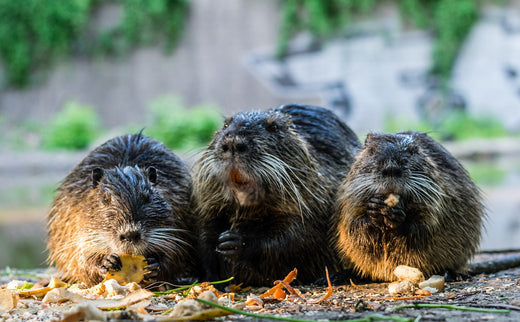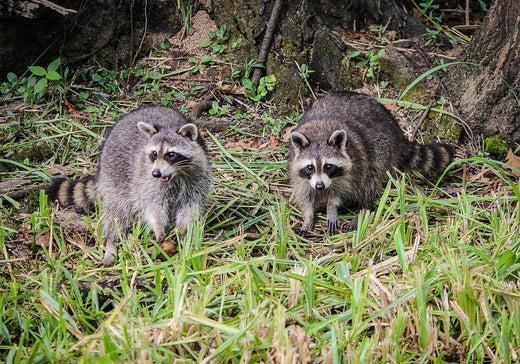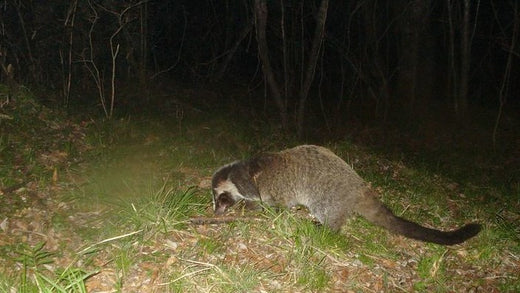The nutria is a large rat native to South America and is a invasive alien species. Specified Alien Species are alien species that originally did not exist in Japan, and are designated by the government as causing damage to ecosystems.
It looks like a capybara or a beaver and is said to be cute, but because it eats waterside plants vigorously, there are reports of agricultural damage to rice and other crops, mainly in western Japan. The amount of damage is about 54 million yen per year nationwide ( *Click here for the figures published by the Ministry of Agriculture, Forestry and Fisheries ).
Characteristics of nutria
The nutria is an animal belonging to the rodent order, with a head and body length of about 55 to 63 cm and a weight of about 6 to 10 kg, which is slightly larger than a cat.
Mainly in western Japan, it has been confirmed to inhabit Okayama, Aichi, Mie, Gifu, Kyoto, Osaka, Hyogo, and Kagawa prefectures. Because it is vulnerable to cold, it is less active in winter and cannot live in cold areas where freezing is seen.
Appearance and ecology
It has dark brown fur, is a rodent and has large orange front teeth.
The tail is long and unlike the body, it does not have much hair. They have webbed feet from the first to the fourth toes on their hind feet, and are good at swimming and diving. The footprints are distinctive (the hind legs are larger than the front legs, and only the hind legs have webbed and trailing marks), making them easy to distinguish from other animal tracks.
They inhabit rivers, waterways, ponds, and other waterside areas in plains.
There is no big difference in appearance between males and females, but males are slightly larger.
Many females give birth in the spring, but they breed regardless of the season, giving birth to an average of five offspring two to three times a year. In addition, the gestation period is about 130 days, and sexual maturity is immediately achieved in about half a year after birth, and breeding is possible. From these facts, it can be said that the fertility is very strong.
diet and personality
As for diet, they prefer to eat the stems and rhizomes of aquatic plants such as lotus, rice, reeds, and water chestnuts. As for crops, they often eat paddy rice seedlings, as well as carrots and sweet potatoes. They are primarily herbivorous, but may also eat animal foods such as shellfish.
It is basically nocturnal and active in search of food at dawn and dusk, but there have been reports of it moving while hiding in drainage ditches during the day.
Compared to raccoons, they have a gentle personality, but they may bite violently when cornered.
The cause of nutria breeding
According to the results of a habitat distribution survey by the Ministry of the Environment, which was released the other day , the habitat distribution area of nutria has expanded significantly. Compared to the distribution of nutria before 2002, there is no change in the basic pattern of distribution west of the Tokai region, but the expansion of the distribution area is particularly noticeable in the Kinki and Chugoku regions.
It is also found on islands in the Seto Inland Sea such as Awajishima and Shodoshima. Nutria first started living in Japan when they were imported from France in 1939 with the aim of increasing fur production.
Named "Swamp Tanuki," which is associated with victory in war, the raccoon dog was bred all over Japan to use its fur as winter clothing for soldiers.
However, after the war, when the demand for them disappeared, they were expelled, and as a result of the escaped individuals becoming wild and breeding, they are now treated as an alien species that destroys the ecosystem.
To prevent damage caused by nutria
Currently, in areas where nutria populations are densely populated, crops that feed on them are being damaged. There are also concerns about flood control problems, such as the weakening of the banks of fields and embankments due to the fact that the banks are full of burrows. In fact, during the heavy rains in western Japan in the summer of 2019, partial collapse of ponds caused by nutria burrows was confirmed in Okayama Prefecture.
In addition, in ponds in Hyogo Prefecture, it is damaging aquatic plants and causing damage to the ecosystem, such as destroying the habitat of the native species, the tortoiseshell dragonfly. For this reason, active control measures are being taken especially in areas where the amount of damage is high.
Environmental management is the foundation
As is the case with other pest control measures, the basis is environmental management to prevent damage.
It is effective to make the environment difficult for nutria to inhabit by cutting and burning grass around fields, abandoned farmlands, and around burrows where feeding damage is a concern. It would be good if each farmer in the area has a common awareness of self-defense and actively weeds.
In addition, nutria have the characteristic of being vulnerable to fluctuations in water level. As a countermeasure when living in a pond, etc., it is also effective to periodically change the water level to create an environment that is difficult for them to live in. In Kasai City, Hyogo Prefecture, it has been reported that the number of confirmed nutria became 0 by performing "jakotori" to catch fish in the pond at the same time as draining water.
Intrusion prevention measures
Nutria have sharp teeth that can tear through nets. Therefore, it is important to install protective fences in combination with tin plates.
Also, as with badgers , it is important to prevent them from digging into the ground. If you use a protective fence, bury the bottom 20 to 30 cm of the fence in the ground. However, if the height is less than 40 cm, they may try to climb over it, so it is better to compensate for the height so that they cannot climb over the fence by embedding it too much.
Capturing with a box trap
Catching nutria is mainly carried out using box traps. A box trap is a trap that traps prey by closing the entrance when the prey enters a box made of a cage or the like and the trigger is activated. Basically any box trap can be used as long as the cage is not too big.
Nutria are not very cautious and are not as difficult to catch as wild boars.
Place the trap in a place where you think nutria are likely to appear frequently, and place the trap so that the entrance faces close to the animal trail or burrow.
Another method is to make a raft and float it on the waterside where the nutria live, and set a box trap on it. In this case, there are few erroneous captures (capture of animals other than the capture target), but there are also disadvantages such as being affected by the weather and requiring labor to set up and collect.
Nutria like sweet and fragrant foods. Also, considering that the trap will be set up for a long time, it is necessary to choose bait that does not spoil easily. Therefore, carrots are often used to catch nutria.
Pumpkins, watermelons, sweet potatoes, etc. may also be used.
Click here for box traps recommended by Inohoi>>
Notes on capturing
・A hunting license (trap license) or permission is required to set up box traps. In that case, you will be registered as a capture worker by taking a course, and you will be able to capture and transport specific alien species without a hunting license.
For details, please check with the department in charge of each local government (Ministry of Agriculture, Forestry and Fisheries, etc.).・If you set up a box trap, make a patrol at least once a day. If you capture a different beast than your target, release it immediately.
・Wild animals may act violently or bite when excited. Nutria have strong jaws and can easily bite through a human finger. Also, since the claws are long, be careful when handling the trap containing the captured individual, such as wearing gloves and holding the trap away from your body. Wild animals, not just nutria, can have illnesses, so if you get injured, seek medical attention.
・Nutria is designated as a specific alien species under the "Act on Prevention of Damage to Ecosystems by Specified Alien Species" (Invasive Alien Species Act). Therefore, feeding (including transportation)
・Transferring (unless permission is granted) and releasing animals are prohibited, and captured animals must be handled appropriately. Regarding the handling of captured beasts, please check in advance with the department in charge of each local government (Agriculture, Forestry and Fisheries Department, etc.).
See also this article >>Regarding raccoon ecology, countermeasures, and extermination

 箱罠
箱罠
 くくり罠
くくり罠
 パーツ類
パーツ類
 電気柵
電気柵
 自作キット
自作キット
 防獣グッズ
防獣グッズ
 監視カメラ
監視カメラ




 box trap
box trap
 tying trap
tying trap
 enclosure trap
enclosure trap
 Prevention and avoidance goods
Prevention and avoidance goods
 electric fence
electric fence
 trap surveillance camera
trap surveillance camera
 transportation goods
transportation goods
 Trap detection sensor
Trap detection sensor
 hunting supplies
hunting supplies
 hunting books
hunting books
 Anti-bird goods
Anti-bird goods
 Agricultural materials/machinery
Agricultural materials/machinery
 boar
boar
 deer
deer
 Kyon
Kyon
 monkey
monkey
 raccoon
raccoon
 Badger
Badger
 palm civet
palm civet
 raccoon dog
raccoon dog
 nutria
nutria
 mouse or rat
mouse or rat
 Mole
Mole
 bear
bear
 pigeon
pigeon
 Crow
Crow







